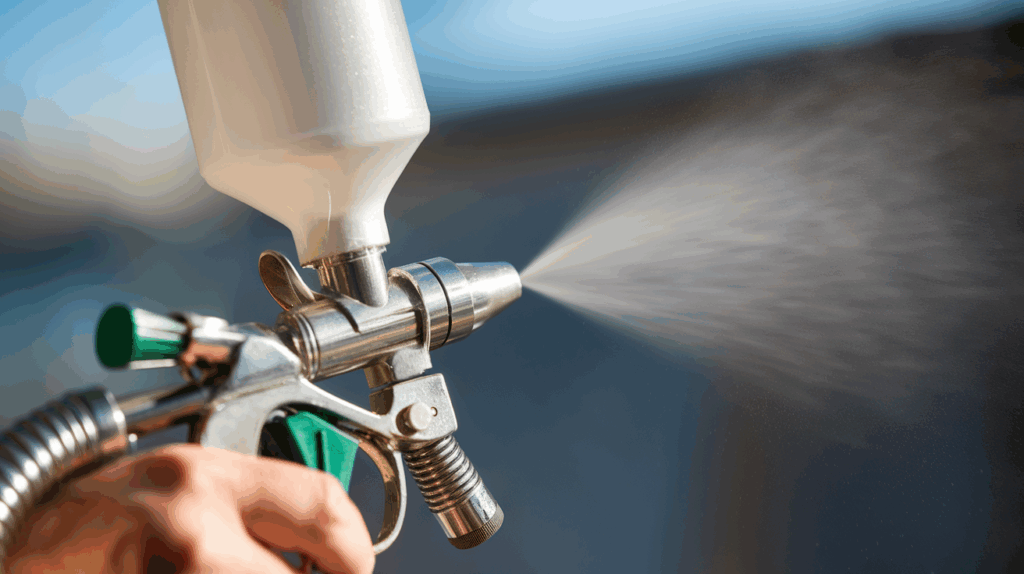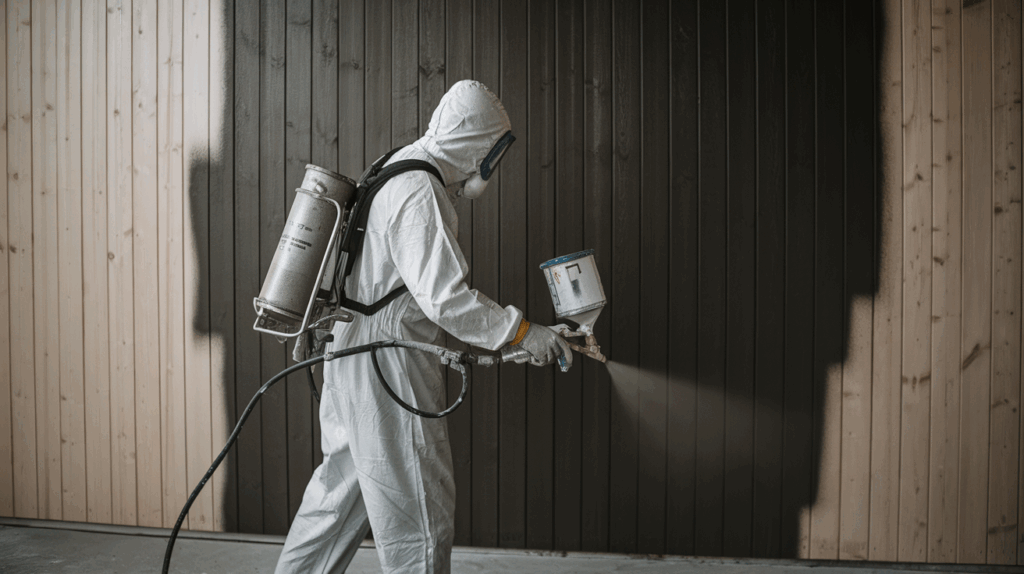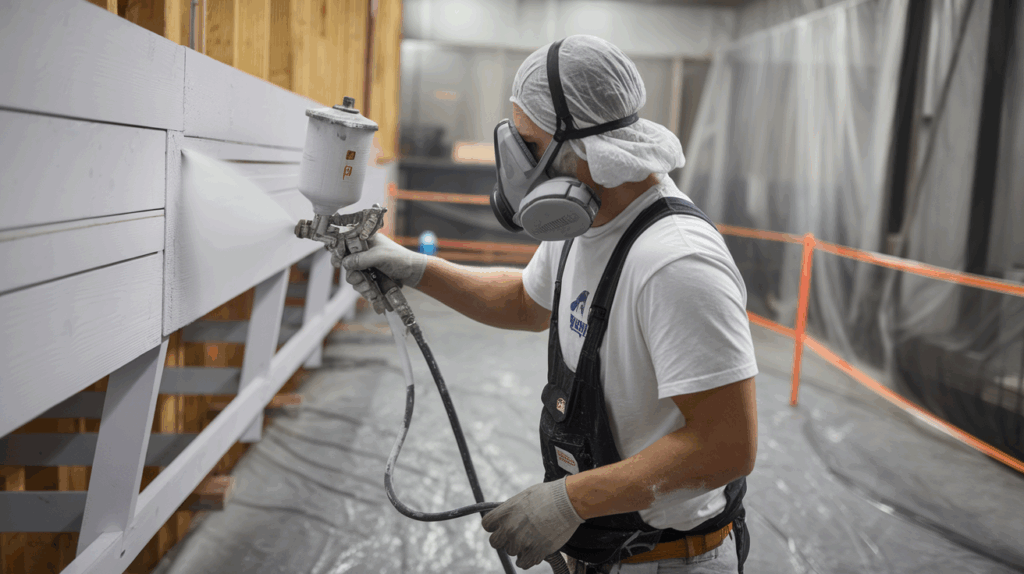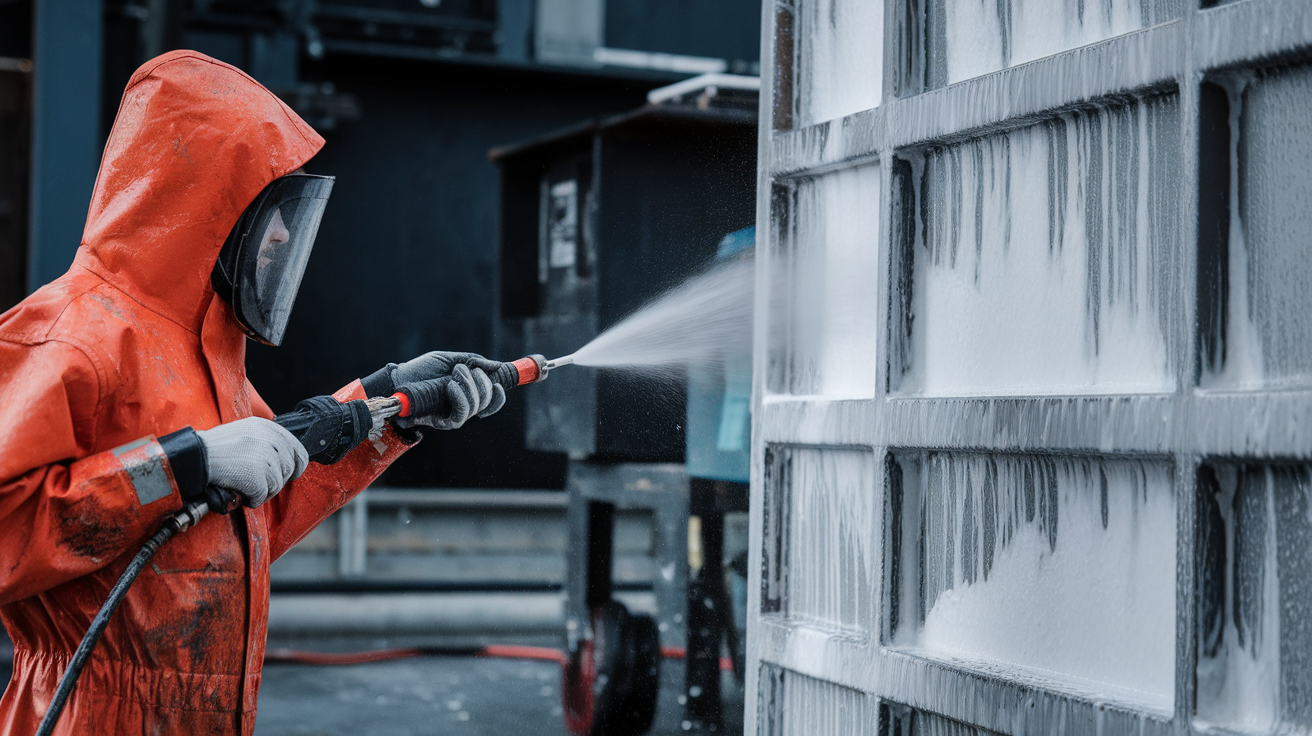Have you ever finished painting a ceiling only to find tiny paint specks all over your floor, furniture, and equipment?
It’s a cleaning nightmare that can add hours to your project. This is where dryfall paint comes in as the perfect answer for large commercial and industrial spaces.
Dryfall paint is special because it dries so quickly that any overspray turns to powder before reaching the floor, making cleanup as easy as sweeping or vacuuming.
In this guide, you’ll learn:
- What makes dryfall paint different from regular paint
- Why does it save time and money on big projects
- How to pick the right type for your needs
I’ve used dryfall paint on hundreds of projects and will share my tried-and-true tips to help you get the best results.
What Is Dryfall Paint?
Dryfall paint is not your normal everyday paint. It’s a special coating that does something pretty cool: it dries while still in the air.
When you spray dryfall on a ceiling, tiny droplets that don’t stick to the surface will fall downward.
But here’s the magic – by the time these droplets reach about 8-10 feet below, they’ve already dried into a fine dust.
This dust won’t stick to floors or equipment. You can sweep or vacuum it up! I’ve seen painters save hours on cleanup with this stuff. You might think of it as a self-cleaning paint for ceilings.
Dryfall comes in a few main types:
- Water-based (acrylic)
- Oil-based (alkyd)
- High-performance epoxy blends
Each type works for different surfaces and conditions. Water-based is my go-to for most jobs because it has less smell and cleans up with just water.
Unlike regular paint that stays wet and sticky, dryfall gives you a no-fuss option for big overhead projects.
The Benefits of Dryfall Coatings

1. Less Cleanup
Forget about sticky messes on your floors. With dryfall paint, the overspray that doesn’t stick to the ceiling turns to dust before hitting the ground.
I’ve saved countless hours on jobs because all you need is a broom or vacuum to clean up. No more scrubbing with chemicals or dealing with paint that won’t come off.
2. Fast Drying
Time is money, especially in business settings. Dryfall dries so quickly that you can often finish a ceiling and get a space back in use the same day.
I once painted a retail store ceiling overnight, and they were open for business the next morning. You won’t have to shut down operations for days waiting for paint to dry.
3. Ceiling-Specific
Regular paint isn’t made for ceilings, but drywall is built for this exact purpose. It sticks well to overhead surfaces and often needs just one coat.
You get better coverage with less product, which saves you money in the long run.
4. Protects Floors and Equipment
The biggest headache with ceiling projects is covering everything below. With dryfall, you only need minimal protection for the immediate work area.
No need to mask off entire rooms or cover every inch of floor space. This makes drywall perfect for factories, warehouses, and stores where moving equipment is difficult or costly.
Tips for Choosing the Right Dryfall Paint

1. Consider the Surface
Not all surfaces need the same paint. For metal ceilings, I recommend using a dryfall with rust inhibitors. If you’re working with drywall, look for products that help hide seams.
The surface type affects how well the paint sticks and lasts. Concrete ceilings often need a primer first, while most metal surfaces can take dryfall directly.
2. Pick the Right Sheen
Sheen matters more than most people think. Flat finishes hide flaws better, making them perfect for old or uneven ceilings.
I’ve found that semi-gloss can boost light in dark spaces by reflecting more light downward.
For most basic jobs, a flat white is your safest bet. But in places like kitchens where you might need to wipe the ceiling, a bit of sheen helps with cleaning.
3. Check the Fall Distance
This one catches many first-timers by surprise. Some dryfall needs at least 8-10 feet of fall distance to dry properly. If your ceilings are lower, you’ll need a “low-fall” version that dries faster.
I once used regular dryfall in a 7-foot hallway and ended up with a sticky mess on the floor. Always check the label for minimum height requirements.
4. Read Labels Carefully
Not all products labeled as “dryfall” work the same way. Some dry faster, some work better in cold spaces, and others have better hiding power. Read the specs and notes from the maker.
The cheapest option often costs more in the end if it doesn’t do what you need. I always check if the paint needs mixing with other products or special spray equipment.
When to Use Dryfall Paints?

1. Warehouses and Factories
These large, open spaces are perfect for dryfall paint. With ceiling heights often reaching 20+ feet, you get plenty of fall distance for the paint to dry.
I’ve painted dozens of warehouses where protecting all the inventory and equipment would have been nearly impossible with regular paint.
You save time and money by not having to cover everything below. The quick-drying nature also means workers can get back to their jobs faster, reducing costly downtime.
2. Retail Stores
Store owners can’t afford to close for days due to painting. Dryfall lets you work overnight and have the store ready for customers the next morning.
You won’t have to worry about paint dripping on merchandise or display cases.
I once repainted a busy clothing store’s ceiling between closing time (9 PM) and opening (10 AM), and shoppers never knew work had been done.
3. Gyms, Schools, and Auditoriums
These busy public spaces need quick fixes with little mess. Dryfall works well in these settings because floor protection is minimal.
Think about a school gym; covering that entire floor would take hours. With dryfall, you only need to protect the direct work area.
Schools especially benefit because work can happen during breaks without leaving sticky residue on bleachers or equipment.
4. New Builds or Renovations
This is the ideal time to use dryfall. When a building is still empty, you can spray the ceilings quickly without worrying about fixtures, furniture, or finished floors.
I always tell my clients to schedule ceiling painting before installing lights or HVAC units.
You’ll get a cleaner finish with fewer touch-ups needed, and the whole job goes much faster when you don’t have to work around obstacles.
What Happens when You Overspray with Dryfall Paint?
When you spray dryfall paint on a ceiling, not all of it sticks to the surface. Some paint droplets miss their target and fall toward the floor. This is where dryfall paint shows its special quality.
Unlike regular paint that would create a wet, sticky mess below, these falling droplets actually dry in mid-air. By the time they reach the floor, they’ve turned into a fine, dry powder.
I remember my first time using dryfall in a warehouse. I was so worried about the mess that I covered everything.
At the end of the day, all I found was some dust-like powder that swept up in minutes!
You can simply sweep or vacuum this powder when you’re done. No scrubbing. No chemical cleaners. No ruined floors. But there’s a catch: dryfall needs enough fall distance to work properly.
If your ceiling is too low (typically under 8-10 feet), the paint might not have enough time to dry before landing. This is why dryfall doesn’t work well for low ceilings in homes or basements.
For most commercial jobs with standard height ceilings, you’ll be amazed at how clean the process is compared to standard painting methods.
Conclusion
Dryfall paint is a smart pick for high ceilings in large spaces; It dries in the air, so overspray turns to dust, and cleanup is easy.
After using it for over a decade in warehouses, schools, and stores, I’ve seen how it speeds up jobs and reduces prep work.
Just make sure to check the fall distance and pick the right type for your surface. If you’re painting a commercial ceiling, dryfall can save you time, effort, and stress.
It’s definitely worth a look for your next big project

